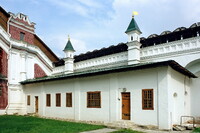| dc.coverage.spatial | Site: Moscow, Rossiya, Russia | en_US |
| dc.coverage.temporal | ca.1524-1700 (inclusive) | en_US |
| dc.creator | unknown (Russian) | en_US |
| dc.date | 1524-1700 | en_US |
| dc.date.accessioned | 2013-01-22T17:44:39Z | |
| dc.date.available | 2013-01-22T17:44:39Z | |
| dc.date.issued | 1524-1700 | en_US |
| dc.identifier | 186598 | en_US |
| dc.identifier.other | archrefid: 1729 | en_US |
| dc.identifier.uri | http://hdl.handle.net/1721.3/93823 | |
| dc.description | Auxillary building at the base of the Bell Tower; Novodevichy Convent is probably the best-known cloister of Moscow. Its name, sometimes translated as the New Maidens' Monastery, was devised to differ from an ancient maidens' convent in the Moscow Kremlin. Unlike other Moscow cloisters, it has remained virtually intact since the 17th century. In 2004, it was proclaimed a UNESCO World Heritage Site. It was built as a fortress at a curve of the Moskva River and became an important part of the southern defensive belt of the capital, which had already included a number of other monasteries. Source: Wikipedia; http://en.wikipedia.org/wiki/Main_Page (accessed 6/23/2009) | en_US |
| dc.rights | © Scott Gilchrist, Archivision, Inc. | en_US |
| dc.subject | architectural exteriors | en_US |
| dc.subject | Seventeenth century | en_US |
| dc.subject | Sixteenth century | en_US |
| dc.subject | Muscovite (style) | en_US |
| dc.title | Novodevichy Convent | en_US |
| dc.title.alternative | Bogoroditse-Smolensky Monastery | en_US |
| dc.type | image | en_US |
| dc.rights.access | Licensed for educational and research use by the MIT community only | en_US |
| dc.identifier.vendorcode | 1A2-R-M-N-F7 | en_US |
| vra.culturalContext | Russian | en_US |
| vra.technique | construction (assembling) | en_US |
| vra.worktype | convent | en_US |
| vra.worktype | fortification | en_US |
| dc.contributor.display | unknown (Russian) | en_US |


